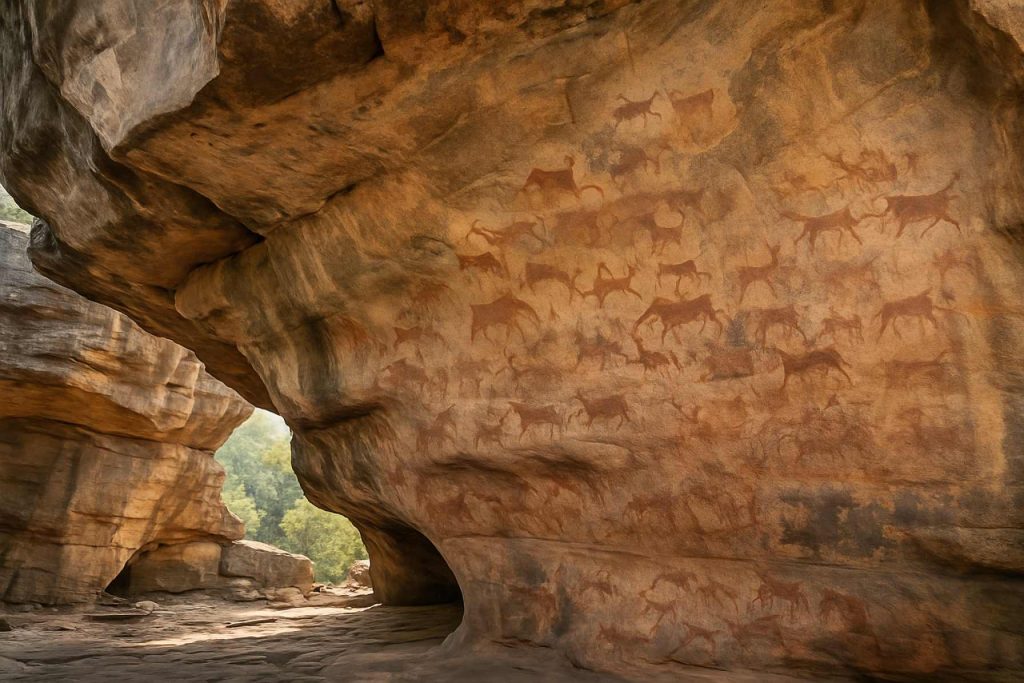
Journey Through Time: How Bhimbetka Rock Shelters Reveal the Dawn of Human Creativity and Ancient Life in India. Discover the World Heritage Site That Continues to Captivate Archaeologists and Historians Alike. (2025)
- Introduction: The Significance of Bhimbetka Rock Shelters
- Geological Formation and Location Insights
- Discovery and Early Archaeological Investigations
- Prehistoric Art: Styles, Techniques, and Symbolism
- Chronology: Dating the Rock Art and Human Habitation
- Cultural and Anthropological Interpretations
- Conservation Efforts and UNESCO World Heritage Status
- Technological Advances in Rock Art Analysis
- Public Engagement, Tourism Trends, and Forecasts (Estimated 15% Growth in Visitor Interest by 2030)
- Future Outlook: Research Directions and Preservation Challenges
- Sources & References
Introduction: The Significance of Bhimbetka Rock Shelters
The Bhimbetka Rock Shelters, located in the central Indian state of Madhya Pradesh, represent one of the most significant archaeological and anthropological sites in South Asia. These natural rock formations, nestled within the foothills of the Vindhyan mountain range, contain more than 700 shelters, of which over 400 are adorned with prehistoric paintings and engravings. The site provides a unique window into the evolution of human life and culture on the Indian subcontinent, with evidence of continuous habitation from the Paleolithic through the Mesolithic and into the historic period.
Recognized as a UNESCO World Heritage Site since 2003, the Bhimbetka Rock Shelters are celebrated for their outstanding universal value. The paintings and artifacts discovered here chronicle the development of human society, depicting scenes of hunting, dancing, communal gatherings, and daily life, as well as the flora and fauna of the region. These artistic expressions, some dating back over 30,000 years, are among the oldest known examples of human creativity and communication, offering crucial insights into the cognitive and cultural evolution of early Homo sapiens.
The significance of Bhimbetka extends beyond its artistic heritage. The site’s stratified deposits have yielded a wealth of archaeological material, including stone tools, pottery, and other cultural remains, which have been instrumental in reconstructing the prehistoric chronology of South Asia. The shelters also demonstrate the adaptation of early humans to changing climatic and environmental conditions, as evidenced by the diversity of rock art styles and the range of faunal depictions.
Bhimbetka’s importance is further underscored by its role in the broader narrative of human migration and settlement. The site’s location at a natural corridor between northern and southern India suggests it may have served as a key waypoint for early populations moving across the subcontinent. Its preservation and study are overseen by the Archaeological Survey of India, the country’s premier organization for archaeological research and heritage management, which ensures the protection and documentation of this invaluable cultural resource.
In summary, the Bhimbetka Rock Shelters are not only a testament to the artistic and technological achievements of prehistoric communities but also a vital source of knowledge about the origins and development of human civilization in South Asia. Their continued study and conservation remain essential for understanding the deep history of humanity.
Geological Formation and Location Insights
The Bhimbetka Rock Shelters, a UNESCO World Heritage Site, are a remarkable ensemble of natural rock formations and prehistoric cave paintings located in the Raisen District of Madhya Pradesh, India. Geologically, these shelters are situated at the southern edge of the Vindhyan mountain range, a region known for its ancient rock systems and significant tectonic history. The Vindhyan range itself is composed primarily of sedimentary rocks, including sandstones, shales, and quartzites, which were deposited during the Proterozoic Eon, making them over 500 million years old. The Bhimbetka site specifically features massive quartzite outcrops, which have been sculpted over millennia by natural weathering processes, resulting in the formation of more than 700 rock shelters and caves.
The unique topography of Bhimbetka is characterized by undulating hills, dense forests, and a network of seasonal streams. The shelters are distributed across seven hills—Bhimbetka, Vinayaka, Bhonrawali, Lakha Juar (East and West), and Jondra—spanning an area of approximately 10 square kilometers. The natural rock formations provided ideal conditions for prehistoric habitation, offering protection from the elements and vantage points for observing the surrounding landscape. The region’s geology not only contributed to the preservation of the rock art but also influenced the choice of pigments, as minerals such as hematite and manganese oxides were locally available and used by ancient artists.
The Bhimbetka Rock Shelters are located about 45 kilometers southeast of Bhopal, the capital city of Madhya Pradesh, and are easily accessible via road and rail networks. The site’s coordinates place it within the Satpura Range’s northern periphery, an area recognized for its ecological diversity and archaeological significance. The proximity to the Betwa River and its tributaries provided a reliable water source, further supporting continuous human occupation from the Paleolithic through the Mesolithic and into the historic periods.
The geological and locational attributes of Bhimbetka have made it a focal point for multidisciplinary research, encompassing archaeology, geology, and anthropology. The site’s significance is underscored by its inclusion in the World Heritage List by UNESCO, which recognizes its outstanding universal value as evidence of early human life and artistic expression in South Asia.
Discovery and Early Archaeological Investigations
The Bhimbetka Rock Shelters, located in the Raisen District of Madhya Pradesh, India, represent one of the most significant prehistoric archaeological sites in South Asia. The discovery of these shelters is credited to Dr. Vishnu Wakankar, an eminent Indian archaeologist, who stumbled upon the site in 1957 while surveying the region for prehistoric remains. Dr. Wakankar recognized the importance of the natural rock formations and the presence of ancient paintings, which prompted systematic archaeological investigations in the following years.
Early explorations revealed that the Bhimbetka complex comprises over 700 rock shelters, of which more than 400 contain prehistoric paintings and engravings. These shelters are situated within the Vindhyan mountain range and are characterized by their unique geological formations, which provided natural habitation for early humans. The initial surveys and excavations, led by Dr. Wakankar and his team, uncovered a wealth of archaeological material, including stone tools, microliths, pottery fragments, and evidence of hearths, indicating continuous human occupation from the Lower Paleolithic period through the Mesolithic and into the historic era.
The first systematic archaeological excavations at Bhimbetka began in the early 1960s, under the supervision of the Archaeological Survey of India (ASI), the premier organization responsible for archaeological research and the protection of cultural heritage in India. The ASI’s investigations confirmed the site’s antiquity, with stratified deposits revealing a long sequence of human activity. The discovery of tools and artifacts associated with Homo erectus and later Homo sapiens provided crucial evidence for understanding the prehistoric cultures of the Indian subcontinent.
The rock art at Bhimbetka, which includes depictions of animals, hunting scenes, and daily life, was also systematically documented during these early investigations. The paintings, executed in natural pigments, are considered among the oldest in the world, with some dating back over 10,000 years. The ASI’s research established Bhimbetka as a key site for the study of prehistoric art and human evolution in South Asia.
In recognition of its outstanding universal value, the Bhimbetka Rock Shelters were inscribed as a UNESCO World Heritage Site in 2003. The ongoing research and conservation efforts are overseen by the Archaeological Survey of India and supported by international organizations such as UNESCO, ensuring the preservation and continued study of this remarkable archaeological treasure.
Prehistoric Art: Styles, Techniques, and Symbolism
The Bhimbetka Rock Shelters, located in the foothills of the Vindhyan Range in central India, are among the world’s most significant prehistoric art sites. Recognized as a UNESCO World Heritage Site, Bhimbetka contains over 700 rock shelters, of which more than 400 feature ancient paintings and engravings. These artworks provide a unique window into the evolution of human creativity, social organization, and symbolic expression from the Paleolithic through the Mesolithic and into the early historic period.
The art at Bhimbetka is characterized by a remarkable diversity of styles and techniques, reflecting the long span of human occupation. The earliest paintings, dating back at least 30,000 years, are typically rendered in red and white pigments derived from natural minerals such as hematite and lime. These early works are often simple linear representations of animals—such as bison, tigers, elephants, and rhinoceroses—depicted with a keen sense of movement and proportion. Over time, the repertoire expanded to include more complex scenes, such as hunting parties, dancing figures, and communal gatherings, indicating the development of social and ritual practices.
Artists at Bhimbetka employed a range of techniques, including finger painting, brushwork using plant fibers, and engraving. The use of superimposition—where newer paintings are layered atop older ones—demonstrates both the continuity and transformation of artistic traditions over millennia. The choice of rock surfaces, often protected from the elements, contributed to the exceptional preservation of these images.
Symbolism is a central feature of Bhimbetka’s prehistoric art. Many motifs, such as geometric patterns, handprints, and stylized human figures, are believed to have held ritual or communicative significance. The frequent depiction of animals suggests their importance in subsistence and spiritual life, while scenes of group activities may reflect early forms of social cohesion and identity. Some scholars interpret certain motifs as early attempts at narrative art, providing insights into the cognitive and cultural development of Homo sapiens in South Asia.
The Bhimbetka Rock Shelters are managed and protected by the Archaeological Survey of India, which conducts ongoing research, conservation, and public education initiatives at the site. The shelters continue to be a focal point for interdisciplinary studies in archaeology, anthropology, and art history, offering invaluable evidence of the origins and evolution of human symbolic behavior.
Chronology: Dating the Rock Art and Human Habitation
The chronology of the Bhimbetka Rock Shelters is central to understanding the evolution of human habitation and artistic expression in the Indian subcontinent. Located in the Raisen District of Madhya Pradesh, India, these shelters provide a continuous record of human presence from the Lower Paleolithic period to the Medieval era. The dating of the rock art and archaeological deposits at Bhimbetka has been established through a combination of stratigraphic analysis, radiometric dating, and stylistic comparisons.
Archaeological excavations at Bhimbetka have revealed a sequence of occupation layers, with the earliest evidence of human activity dating back to approximately 100,000 years ago. This is based on the discovery of Acheulean stone tools and faunal remains in the lower strata, which are characteristic of the Lower Paleolithic period. Thermoluminescence and radiocarbon dating techniques have been employed to confirm the antiquity of these deposits, providing a scientific basis for the chronology of the site.
The rock art at Bhimbetka spans several distinct phases, reflecting changes in human society, technology, and environment. The earliest paintings, attributed to the Mesolithic period (circa 10,000–5,000 BCE), depict hunting scenes, animal figures, and geometric patterns. These are executed in natural mineral pigments, primarily red and white, and are often superimposed by later artworks. Subsequent phases, corresponding to the Chalcolithic and Early Historic periods, introduce new motifs such as domesticated animals, agricultural activities, and more complex human figures. The persistence of artistic activity into the Medieval period is evidenced by depictions of religious symbols and inscriptions.
The chronological framework for Bhimbetka’s rock art has been refined through comparative studies with other prehistoric sites in India and abroad. The Archaeological Survey of India, the primary governmental body responsible for archaeological research and heritage management in the country, has played a pivotal role in systematic excavations and conservation efforts at Bhimbetka. Their findings have been corroborated by international collaborations and scientific analyses, ensuring the reliability of the dating methods used.
In recognition of its outstanding universal value, the Bhimbetka Rock Shelters were inscribed as a UNESCO World Heritage Site in 2003. The UNESCO designation underscores the significance of Bhimbetka as a testament to the continuity of human settlement and artistic endeavor over tens of thousands of years, making it a key reference point for the study of prehistoric chronology in South Asia.
Cultural and Anthropological Interpretations
The Bhimbetka Rock Shelters, located in the foothills of the Vindhyan Range in central India, are a remarkable testament to the cultural and anthropological evolution of early human societies in South Asia. These shelters, inscribed as a UNESCO World Heritage Site, contain one of the largest and oldest collections of prehistoric art in the world, with paintings and engravings that span from the Paleolithic to the Medieval period. The site’s significance lies not only in its antiquity but also in the continuity and diversity of human occupation and artistic expression it documents.
Anthropologically, Bhimbetka provides crucial evidence of the cognitive and social development of early Homo sapiens in the Indian subcontinent. The rock art, which includes depictions of hunting scenes, dancing, communal gatherings, and various animals, offers insights into the daily lives, beliefs, and rituals of prehistoric communities. The recurring motifs of animals such as bison, tigers, and elephants, alongside human figures, suggest a close relationship between humans and their environment, as well as the symbolic or spiritual significance attributed to these creatures.
Cultural interpretations of the Bhimbetka paintings reveal a dynamic interplay between tradition and innovation. The stylistic evolution observed in the art—from simple geometric patterns and handprints to more complex narrative scenes—reflects changes in social organization, technological advancement, and possibly the emergence of religious or mythological thought. Some scholars interpret the presence of dance and music scenes as evidence of communal rituals, possibly linked to fertility, hunting magic, or social cohesion.
The shelters themselves, naturally formed in sandstone outcrops, were strategically chosen for habitation due to their protection from the elements and proximity to water sources. Archaeological excavations have uncovered stone tools, pottery, and other artifacts, indicating a long sequence of occupation by hunter-gatherer groups, followed by early agricultural communities. This continuity underscores Bhimbetka’s role as a cultural crossroads, where different groups interacted, exchanged ideas, and adapted to changing environments.
The preservation and study of Bhimbetka are overseen by the Archaeological Survey of India, which is responsible for the conservation of the site and the interpretation of its findings. Internationally, organizations such as UNESCO recognize Bhimbetka as a site of outstanding universal value, highlighting its contribution to our understanding of human creativity and the development of symbolic behavior. Ongoing research continues to refine our knowledge of the cultural and anthropological significance of Bhimbetka, making it a focal point for studies on early human societies in South Asia.
Conservation Efforts and UNESCO World Heritage Status
The Bhimbetka Rock Shelters, located in the Raisen District of Madhya Pradesh, India, are a remarkable testament to prehistoric human life, featuring some of the earliest traces of human habitation and rock art in South Asia. Recognizing their outstanding universal value, the United Nations Educational, Scientific and Cultural Organization (UNESCO) inscribed the Bhimbetka Rock Shelters as a World Heritage Site in 2003. This designation underscores the site’s significance as an exceptional repository of prehistoric art and culture, spanning from the Paleolithic to the Medieval period.
UNESCO’s World Heritage status has played a pivotal role in shaping conservation strategies for Bhimbetka. The site is protected under the Ancient Monuments and Archaeological Sites and Remains Act, 1958, administered by the Archaeological Survey of India (ASI). The ASI, a government agency under the Ministry of Culture, is responsible for the maintenance, conservation, and management of the shelters. Their efforts include regular monitoring, structural stabilization of the rock formations, and the implementation of measures to prevent vandalism and environmental degradation.
Conservation at Bhimbetka is particularly challenging due to the delicate nature of the rock art, which is susceptible to weathering, biological growth, and human interference. The ASI employs a multidisciplinary approach, involving archaeologists, conservation scientists, and heritage managers, to ensure the preservation of both the physical structures and the invaluable paintings. Techniques such as controlled visitor access, installation of informative signage, and the use of non-invasive cleaning methods are employed to minimize impact on the site.
In addition to national efforts, UNESCO provides technical guidance and encourages the adoption of best practices in heritage management. The World Heritage Committee periodically reviews the state of conservation at Bhimbetka, offering recommendations to enhance protection and sustainable tourism. Community engagement is also a key aspect, with local stakeholders being involved in awareness programs and site stewardship initiatives.
Despite these efforts, ongoing challenges persist, including the threat of encroachment, unregulated tourism, and environmental factors such as water seepage and lichen growth. Addressing these requires continuous collaboration between the ASI, UNESCO, local authorities, and the broader public. The recognition of Bhimbetka as a World Heritage Site has not only elevated its global profile but also reinforced the commitment to safeguarding this irreplaceable cultural legacy for future generations.
Technological Advances in Rock Art Analysis
The Bhimbetka Rock Shelters, a UNESCO World Heritage Site, are renowned for their extensive collection of prehistoric rock art, spanning from the Paleolithic to the Medieval period. Recent technological advances have significantly enhanced the analysis and interpretation of these ancient artworks, providing deeper insights into the lives and cultures of early human societies in the Indian subcontinent.
One of the most transformative developments has been the application of non-invasive digital documentation techniques. High-resolution 3D laser scanning and photogrammetry now allow researchers to create precise digital replicas of the shelters and their paintings. These methods capture minute details of the rock surfaces and pigment layers without physical contact, preserving the integrity of the fragile art. Such digital models facilitate remote analysis, comparative studies, and virtual restoration, ensuring that the data remains accessible for future generations and for researchers worldwide.
Multispectral and hyperspectral imaging have also revolutionized the study of Bhimbetka’s rock art. By capturing images across various wavelengths, these technologies reveal faded or invisible paintings, distinguish between different pigment compositions, and help identify chronological layers of artwork. This has enabled archaeologists to reconstruct sequences of artistic activity and better understand the evolution of symbolic expression at the site.
Advances in portable X-ray fluorescence (pXRF) and Raman spectroscopy have further contributed to the non-destructive analysis of pigments and mineral substrates. These techniques provide detailed information about the chemical composition of the materials used by ancient artists, shedding light on their resource procurement strategies, trade networks, and technological capabilities. Such analyses have revealed the use of locally available minerals, as well as evidence of sophisticated preparation and application methods.
Geographic Information Systems (GIS) are increasingly employed to map the spatial distribution of shelters, motifs, and archaeological features within the Bhimbetka complex. GIS-based studies help researchers understand patterns of site selection, landscape use, and the relationship between rock art and environmental factors. This spatial perspective is crucial for reconstructing the social and ecological context of the region’s prehistoric inhabitants.
These technological advances are often implemented in collaboration with national and international heritage organizations. The Archaeological Survey of India, which manages the Bhimbetka site, plays a central role in facilitating research, conservation, and public dissemination of findings. Partnerships with academic institutions and global heritage bodies ensure that the latest scientific methods are applied to safeguard and interpret this invaluable cultural legacy.
Public Engagement, Tourism Trends, and Forecasts (Estimated 15% Growth in Visitor Interest by 2030)
The Bhimbetka Rock Shelters, a UNESCO World Heritage Site, have witnessed a steady rise in public engagement and tourism over the past decade. Located in the Raisen District of Madhya Pradesh, India, these prehistoric caves are renowned for their ancient rock paintings, some dating back over 30,000 years. The site’s unique blend of archaeological, anthropological, and natural significance has made it a focal point for both domestic and international visitors.
Public engagement initiatives have played a crucial role in increasing awareness and appreciation of Bhimbetka’s heritage. The Archaeological Survey of India (ASI), the primary custodian of the site, has implemented educational programs, guided tours, and interpretive signage to enhance visitor experience and understanding. Collaborations with local communities and academic institutions have further enriched outreach efforts, fostering a sense of stewardship and cultural pride among residents and stakeholders.
Tourism trends at Bhimbetka reflect broader patterns in heritage tourism across India. According to data from the Archaeological Survey of India, visitor numbers have shown consistent growth, with a notable increase in school groups, researchers, and international tourists. The site’s inclusion in UNESCO’s World Heritage list has amplified its global profile, attracting cultural tourists seeking authentic and educational experiences. Infrastructure improvements, such as better road connectivity and visitor amenities, have also contributed to the site’s accessibility and appeal.
Looking ahead, forecasts suggest an estimated 15% growth in visitor interest by 2030. This projection is based on several factors: rising global interest in prehistoric art and archaeology, government initiatives to promote heritage tourism, and the increasing popularity of experiential travel. The Ministry of Tourism, Government of India has identified Bhimbetka as a key destination in its promotional campaigns, further boosting its visibility. Digital engagement, including virtual tours and online educational resources, is expected to complement on-site visits, broadening the site’s reach to global audiences.
To sustainably manage this anticipated growth, ongoing efforts focus on balancing conservation with visitor access. The ASI, in partnership with UNESCO and local authorities, continues to monitor site integrity, implement visitor management strategies, and promote responsible tourism practices. These measures aim to ensure that increased public engagement and tourism contribute positively to the preservation and appreciation of Bhimbetka’s invaluable heritage for future generations.
Future Outlook: Research Directions and Preservation Challenges
The Bhimbetka Rock Shelters, a UNESCO World Heritage Site, continue to be a focal point for archaeological and anthropological research, offering invaluable insights into early human life in the Indian subcontinent. As we look toward 2025 and beyond, the future outlook for Bhimbetka encompasses both promising research directions and significant preservation challenges.
Emerging research is increasingly interdisciplinary, integrating advanced technologies such as 3D laser scanning, digital mapping, and non-invasive geophysical surveys. These methods allow for detailed documentation of the shelters and their rock art without causing physical harm, enabling researchers to analyze pigment composition, stratigraphy, and micro-environmental changes. Such approaches are expected to yield new information about the chronology of human occupation, the evolution of artistic expression, and the environmental context of the site. Collaborative projects involving Indian and international institutions are likely to expand, fostering a more comprehensive understanding of Bhimbetka’s role in global prehistory.
However, the preservation of Bhimbetka faces mounting challenges. Natural weathering, biological growth (such as lichen and algae), and the impact of fluctuating climate conditions threaten the integrity of the rock art and the shelters themselves. Human-induced pressures—including unregulated tourism, vandalism, and encroachment—further exacerbate these risks. The Archaeological Survey of India (ASI), the primary custodian of the site, has implemented conservation measures such as controlled visitor access, protective barriers, and regular monitoring. Yet, the need for more robust, science-based conservation strategies is increasingly recognized, especially in the face of climate change and growing visitor numbers.
Looking ahead, the integration of community engagement and public education will be crucial. Involving local communities in preservation efforts not only fosters stewardship but also ensures that conservation measures are culturally sensitive and sustainable. Additionally, digital initiatives—such as virtual tours and open-access databases—can help balance public interest with site protection, making Bhimbetka’s heritage accessible to a global audience while minimizing physical impact.
In summary, the future of Bhimbetka Rock Shelters hinges on the synergy between cutting-edge research, effective conservation, and inclusive management. Continued support from national bodies like the Archaeological Survey of India and international organizations such as UNESCO will be vital in safeguarding this irreplaceable window into humanity’s distant past for generations to come.



